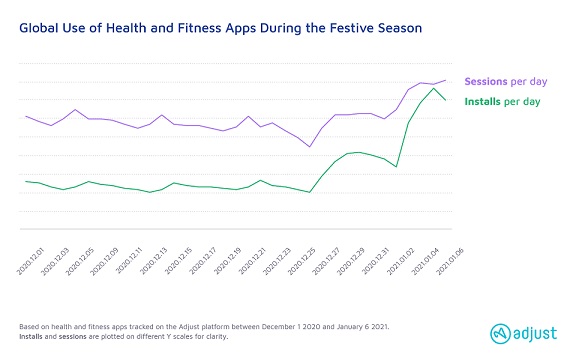Adjust Sales VP’s Retention Strategies for Wellness Apps

Following is a guest post that Adjust regional sales vice president Melissa Dickman wrote for Athletech News.
Home Workouts Here to Stay: Build Gains for Your Health and Wellness Apps with These Retention Strategies
by Melissa Dickman, regional vice president of Sales U.S. East and LATAM at Adjust
In-line with previous years, installs of health and fitness and productivity apps dominated on New Year’s Day as consumers focused on getting the year off to a positive start — mentally and physically.
The New Year is synonymous with self-improvement, with consumers around the world looking to improve their physical and mental health and wellbeing. For mobile apps, that means installs and sessions — or the average length of time users actively engage with an app — for health, fitness and wellness apps generally peak in January, before tapering off throughout the year.
While mobile usage patterns fluctuated throughout 2020, New Year’s resolutions-related health and fitness app activity has remained consistent during the pandemic. Installs in the first week of January 2021 increased nearly 90% compared to the December 2020 average.
Research from Adjust finds that the pandemic, still keeping gyms closed, has not affected motivation for New Year’s resolutions. While health and fitness apps took a dive globally during Christmas 2020, users hit the ground running in the first week of January 2021 — with installs 89% and sessions 24% higher than the December average.
A similar trend was identified with calorie tracking apps, which appeared low on the agenda on Christmas Day, but saw installs climb 91% and sessions jump 34% by the first week of January. The US was most interested in counting calories — reporting an installs increase of 120%!
And this trend is here to stay. A recent consumer survey from Gympass reveals that roughly 83% of Americans are willing to workout from home post-pandemic, while TD Ameritrade found that 59% don’t plan to return to a physical gym.
For many health and fitness apps, the goal is to avoid the typical January rise-and-fall. Rather than pull budgets away from user acquisition (UA), they’re increasing their focus on retention and monetization through subscriptions. Now more than ever, marketing strategists want to create loyalty and trust among their members to increase the frequency of visits or content consumption within the app.
Increasing time spent in-app undoubtedly increases brand recognition and retention. Take control of your data and keep the following key points in mind.
Taking advantage of install peaks
Mobile app installs for health and fitness in January 2020 were relatively high (5.8% above the yearly average), but sessions didn’t actually budge as a result of these specific installs. When lockdowns peaked in March to May, so did install volume. There was then a drop-off, although not to the same extent we saw with the January cohort.
But when quarantine restrictions eased in July of 2020, installs rose 7% over 2019, with sessions soaring 61%. The users acquired were more willing to stay active in apps — adapting to their ‘new normal’. A solid retention strategy is key following these high volume install events.
Retention strategies you need to know
You can think about retention by testing your own habits.
Imagine you have 10 minutes free and you reach for your phone. Which app are you going to open? Developers want to be the ‘go-to’ when a certain activity is undertaken — in this case, when a user wants to work out.
To get their newly acquired consumers to stick around, marketers need solid retention strategies. How can you create a superfan or brand ambassador? Start by learning consumption habits and lean in. How is the app being used and how can you increase retention from day one — by creating default behaviors. Test and learn — a badge here, loyalty rewards there.
Develop a custom onboarding strategy
This is where you can use information including gender, age group, location, favorite sport, fitness level etc. to create a personalized app experience and push for first days’ retention. The better you understand your users and their workout preferences, the better you can cater to them.
Use in-app retention incentives
Create a mechanism for incentivizing users to open your app regularly. One common example for fitness apps is ‘streak days,’ where users are rewarded for engaging with the app or working out for a specific number of days. Rewards could include in-app loyalty points, trophies and medals, and premium features. Nike gives users the opportunity to participate in draws for limited edition sneakers — a nice way to bring an ‘in-store’ feeling to an app.
Implement push notifications and in-app messages
CleverTap just released marketing survey research showing nearly 80% of companies use push notifications to keep customers engaged with their app. For effective communication, request the right permissions and optimize to find the perfect number of notifications to send, at just the right times. This ensures you are encouraging and motivating users to reach their health and fitness goals with your app — not irritating them with irrelevant, ill-timed messages.
As Noah Weiss, Head of Search, Learning, & Intelligence at Slack, puts it so succinctly, “A great push notification is three things: timely, personal and actionable.” Different cohorts respond better at specific times, and notifications should account for a user’s stage in their journey and the parts of your app they’re engaging with.
Paid retargeting campaigns
To help re-engage lapsed users, marketers should assess data points to determine which cohorts to retarget. Take into account the number of sessions the user previously had with the app, their life-time value (LTV), or the campaign the install was attributed to.
User behaviors are currently shifting from pandemic ‘crisis-mode’ into the ‘new normal,’ making it a crucial moment to engage them in building new habits.
Subscriptions: the new ‘gym membership’
Operating with a subscription-based model makes perfect sense for health and fitness apps, as users are already accustomed to paying membership fees for gyms and studios. Given that many real-life fitness mediums are on indefinite hiatus, personal budgets previously allocated to them have been freed up. WW International has adapted by increasing its premium offering, now offering users podcasts and live streams with coaches.
A recent Adjust survey found that users spend an average of $20.78 a month on subscriptions, with Gen Z and Millennials reporting that they have stopped paying for services like gym memberships in order to buy subscriptions on mobile app services — like health and fitness apps. One way to gain an edge in this increasingly competitive space is by offering free trials. For instance, last March, meditation app Headspace offered a one-year premium subscription to Headspace Plus for all Americans and people living in the UK who are unemployed or furloughed. This led to a tenfold increase in the number of users completing stress meditations.
Understanding user behavior is essential to retention
Clean data is essential to understanding your full conversion funnel and customer journey — when a customer starts a free trial, to when they become a paying customer, pause their subscription or even experience a billing problem. Better visibility means the ability to confidently invest in the right channels, iron out user journeys to prevent churn and most importantly to boost the LTV of your members.
Implement these strategies and you’ll be able to build a more loyal customer base. After all, being able to increase your endurance or mental agility from the comfort of your own home is worthy of the shifting trends brought on by the pandemic.

Melissa Dickman, Regional VP of Sales US East and LATAM at Adjust
Adjust is a global app marketing platform. Born at the heart of the mobile app economy and grown out of a passion for technology, the company has 16 offices around the world.
Adjust’s platform includes measurement, fraud prevention, cybersecurity and marketing automation products. Together, they make marketing simpler, smarter and more secure for the 50,000 apps working with Adjust. Global leading brands including Viber, N26, Jam City, Lumos, Rocket Internet and Tencent Games have implemented its solutions to secure their budgets and improve results.



